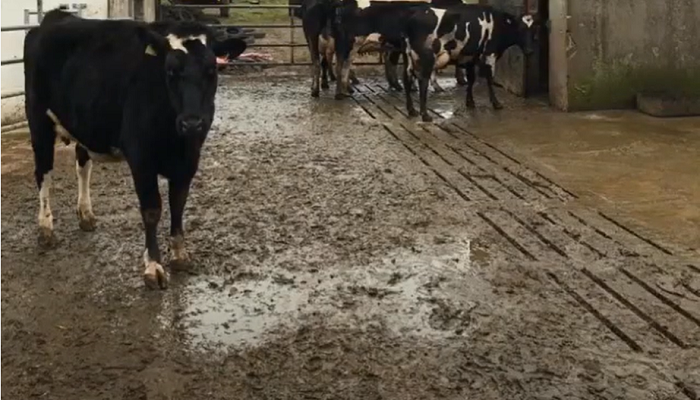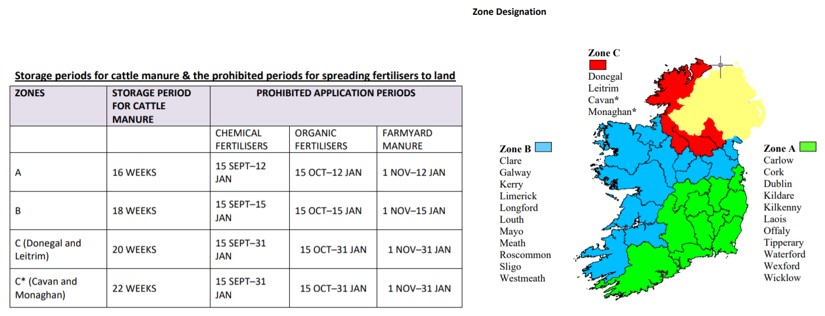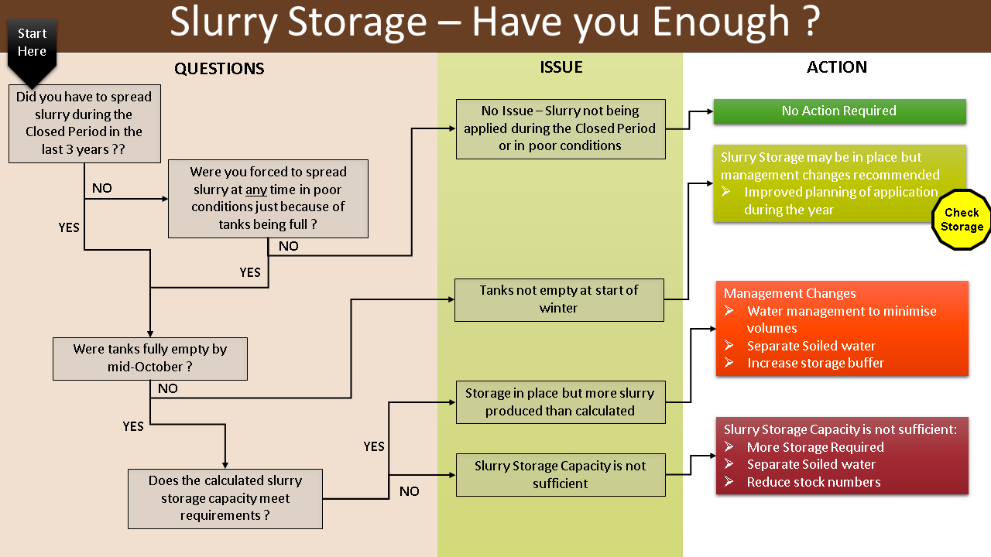25 May 2021
Slurry Storage, Have you enough?

The impact of dairy farming systems on the environment is of critical importance in gaining access to premium dairy markets that will return a good milk price to the farmer. Tom Curran, Regional Manager, Cork West and Tim Hyde, Environment Specialist, Teagasc discuss slurry storage as a key factor
The impact of dairy farming systems on the environment is of critical importance in gaining access to new markets, increasing market share in existing markets while also maintaining access to premium dairy markets that will return a good milk price to the farmer. Our dairy farming systems must operate in harmony with the surrounding environment and we are obligated to contribute to reducing our carbon footprint while at the same time improving water quality and biodiversity on our farms.
Slurry storage and use
The storage and the use of slurry is a key factor in this sustainability. We have to change our view on what slurry is! Slurry is a valuable resource rather than a waste product. Put simply, just as grass is the cheapest feed for cows, slurry is the cheapest source of nutrients available to farmers to grow grass. Every kg of grass that you can produce from slurry, reduces the chemical fertiliser that you have to buy to grow the grass. For example 3,000gals/ac of good quality slurry (6% DM) applied to 1st cut silage fields will supply approx. 30% of the crops N requirements and all P & K requirements. The Ag Climatise roadmap mentions that chemical fertiliser usage needs to drop by 20% over the coming years. It also sets a target to have 75% of slurry spread by Low Emissions Slurry Spreading equipment by 2025. The efficient use of slurry will increase your profit margin on every litre of milk.
The storage and the use of slurry is a key factor in sustainability
In an environment, where chemical fertilisers are expensive and where their use is going to be subject to increased regulation, farmers must use slurry as the Number 1 source of nutrients on the farm. Only then should you top up with chemical fertiliser to meet your crop requirements.
This article will focus on the first part of the equation, do you have enough storage to allow you to use this slurry at the correct times of the year? The correct time of the year is when grass is actually growing. For most soils this is when soil temperature is greater than 5-6o Celsius. So for dry soils, this could be late January in a warm dry spring. But for heavy or peat soils, this could be the early to mid-March.
Over the winter period, when grass growth is low at up to5kgs DM/ha/day, the uptake of nutrients is also very low. Surplus nutrients are easily lost by runoff (P) or through leaching (N). This is confirmed by research which shows that the biggest loss of nutrients from farmland to watercourses occurs in late autumn, through the winter and early spring. There has been and continues to be a lot of criticism of farming by the calendar but this misses the point in relation to the impact of out of season spreading on the quality of water in our nearby streams and lakes and estuaries. Out of season spreading brings the amount of slurry storage available on the farm and the management of that storage very much into the limelight.
Some Key Questions to ask yourself are as follows:
- Were all slurry stores empty at the beginning of the last winter?
- Have you had to go out to spread slurry during the closed period?
- Depending on the zone you are in, had you enough storage from the start of the normal winter housing period?
- Are you concerned that this is an issue on your farm?
- When did you first spread slurry this winter? (If you spread slurry between the end of the closed period and the 15th Feb it is an indicator of storage shortage or issues within the farmyard)?
- Where are your dairy/parlour/collecting yard/pit washings stored on the farm?
- Have you excessive straw bedding in your storage calculations that is not actually used in practice?
- Have you considered or planned any solutions to rectify any storage shortage?
Zone designation below (ref DAFM Nitrates Explanatory Handbook)


Farmers who have insufficient slurry storage to meet the requirements of 16; 18; 20 or 22 weeks may be in breach of the nitrates regulations. It is strongly recommended that all farmers plan for a minimum buffer of 20% or an additional 2-4 weeks storage over and above the minimum Nitrates Regulation requirements.
Why have extra storage?
- More flexibility to match slurry application timings with grass growth.
- Better use of nutrients when grass is growing.
- To better manage increased rainfall events at the shoulders of the year.
- Provide cover for miscellaneous issues where water enters tanks and reduces capacity.
- Enough storage to meet the regulations and a buffer of 20% to cover miscellaneous occurrences.
- Use slurry to replace one round of chemical fertiliser/year
- Apply slurry at correct time to maximise the fertiliser replacement value (N, P & K) of slurry
- TAMS Grants are available to farmers for additional slurry storage 40-60% and this can also be written off against tax and the VAT is reclaimable.
Complete storage assessment
The best way to start is to complete a full assessment of your farmyard with your Teagasc advisor for slurry, FYM, Soiled Water, Dairy Washings and Silage Effluent and come up with a plan to ensure you have enough storage to suit your farm. Your advisor will calculate what storage you already have and what the shortfall is in terms of overall storage capacity required for the number of animals that you currently have or will have in the future. Remember, if your stock numbers have already increased or are increasing, your slurry storage must also increase. So build the cost of providing this additional storage into your business plan before you start increasing.
When doing the farmyard assessment pay particular attention to where your dairy and parlour washings are stored. If they are stored in a slurry tank, they are classified as slurry and will significantly eat into the storage available to you. Another area of attention is straw bedding. If animals are actually wintered on straw bedding, it is perfectly fine. In general, straw bedding is expensive and only a short term ‘fix’. Loose housing such as calving boxes, calf sheds or short-term calving areas cannot be included as available storage for these calculations.
Make sure that all clean rain water including roof water is diverted away from the farmyard. Keep soiled yards to a minimum. Keep silage pits clean and tidy so that winter runoff can be diverted away from storage facilities. Farmyards need to be managed in line with local authority requirements. A key point in all this discussion is that you can have the best facilities in the country but if they are not managed well during the year, you can still run into trouble.
Moving forward
Tackling this problem is very farm specific. It is rarely as simple as just building new extra storage. Take a step by step approach to increasing capacity along the following lines:
- Install a drainage system to deal with clean surface waters, eaves and downpipes.
- Where appropriate, reduce stock numbers to match available storage capacity.
- Remove stock from outdoor feeding yards by
- Cover open tanks and/or open soiled yards.
- Construct new storage tanks/animal housing where necessary
- Divert all dirty water to storage tanks and include in any calculations.
Next Steps
Get in contact with your local Teagasc advisor to complete the farmyard assessment and discuss options. Prioritise easy fixes, discuss timelines/completion dates. Ideally a farm visit is required if and when COVID restrictions allow. In the meantime you can do this over the phone, on Skype or Zoom with your advisor. So get in touch with your local office to arrange a suitable date and time.
If you liked this article you might also like to read Slurry Storage Capacity and TAMS
You can contact any of our Teagasc offices using this link Teagasc Advisory Regions here
This article featured in the Today’s Farm Magazine. Today’s Farm is a Teagasc publication. If you liked this article, you might like others in this publication Today’s Farm (May/June) here

